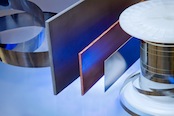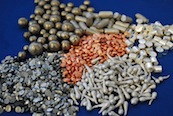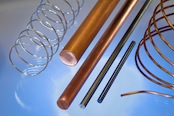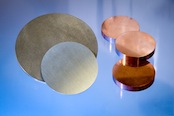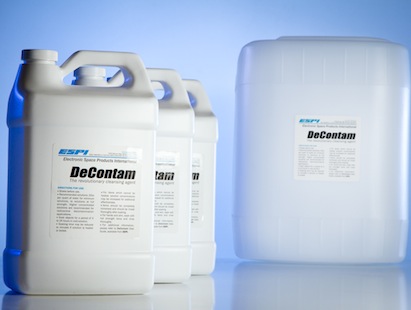Zinc
Zinc is a shining white metal with a bluish gray luster (called spelter) that is malleable at 100 - 150 oC and is strongly electropositive. Zinc foil will ignite in the presence of moisture. The largest single use for zinc is coating (galvanizing) steel or iron and other metals. Another major use for zinc is as a constituent in alloys (brass, bronze, and die-casting alloys). Zinc is also used for electroplating, metal spraying, automotive parts, electrical fuses, storage and dry cell batteries, fungicides, nutrition (essential growth element), roofing, gutters, engravers' plates, cable wrappings and organ pipes.
Physical Properties:
Crystal Structure: Close-packed hexagonal
Atomic Weight: 65.38
Density: 7.133 g/cc (at 25 oC)
Thermal Properties:
Melting Point: 420 oC
Boiling Point: 906 oC
Coefficient of Thermal Expansion:
Linear, Single Crystals at 0 to 100 oC; 15 μm/m ⋅ K along a axis,
61.5 μm/m ⋅ K along c axis.
Polycrystalline solid at 20 to 250 oC: 39.7 µm/m ⋅ K; temperature effect,
LT = L0 (1 + 35.4 x 10-8 T + x 10-8 T2).
Liquid at 500 to 600 oC, 60 µm/m ⋅ K
Specific Heat: 0.382 kJ/kg ⋅ K at 20 oC
Latent Heat of Fusion: 100.9 kJ/kg
Latent Heat of Vaporization: 1.782 MJ/kg
Thermal Conductivity: 113 W/m ⋅ K at 25 oC
Heat of Combustion: -341 MJ/kg Zn
Electrical Properties:
Electrical Conductivity: 28.27% IACS
Electrical Resistivity:
Single Crystals at 20 oC: 58.9 nΩ ⋅ m along a axis, 61.6 nΩ ⋅ m along c axis.
Polycrystalline solid: 59.16 nΩ ⋅ m at 20 oC;
Temperature coefficient at 0 to 100 oC, 0.0419 nΩ ⋅ m per K;
Pressure coefficient at room temperature (calculated),
-25 nΩ ⋅ m per TPa at 100 kPa to 300 MPa
Electrochemical Equivalent: 338.8 µg/C
Electrolytic Solution Potential: -0.7618 V versus standard hydrogen electrode
Hydrogen Overvoltage: 0.75 V at 108 A/m2 for metal rubbed with fine emery
Temperature of Superconductivity: 0.84 + 0.05 K
Magnetic Properties:
Magnetic Susceptibility: Volume: -123 x 10-6 mks
Optical Properties:
Color: Blue-white
Spectral Reflectance: 74.7% at λ = 0.5000 µm; 69.9% at λ = 0.8000 µm; 53.3% at λ = 1.0100 µm; 70.0% at λ = 1.1300 µm
Refractive Index: 1.19 in white light (λ = 0.5500 µm); ρ = 70o; 2ψ = 74o39'
Absorptive Index: 3.71 in white light (λ = 0.5500 µm); ρ = 70o; 2ψ = 74o39'
Mechanical Properties:
Modulus of Elasticity: 10 to 20 x 106 psi (actually no region of strict proportionality between stress and strain in polycrystalline zinc)
Coefficient of Friction: 0.21, rolled zinc versus rolled zinc
Surface Tension: Liquid, 0.755 N/m at 450 oC
Velocity of Sound: 3.67 km/s at room temperature (shape and size of specimen wire unknown)

 ALLOYS
ALLOYS 
